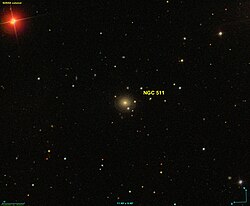NGC 511
| NGC 511 | |
|---|---|
 SDSS view of NGC 511 | |
| Observation data (J2000[1] epoch) | |
| Constellation | Pisces[2] |
| Right ascension | 01h 23m 30.7s[3] |
| Declination | +11° 17′ 28″[3] |
| Redshift | 0.03723 ± 0.00015[1] |
| Heliocentric radial velocity | (10954 ± 44) km/s[1] |
| Distance | 499 Mly[4] |
| Apparent magnitude (V) | 13.9[2] |
| Apparent magnitude (B) | 14.9[2] |
| Characteristics | |
| Type | E[2] |
| Apparent size (V) | 1.1' × 1.1'[2] |
| Other designations | |
| PGC 5103, UGC 936, GC 5174, MGC +02-04-033, 2MASS J01233074+1117274 [1][5] | |
NGC 511, also occasionally referred to as PGC 5103 or UGC 936, is an elliptical galaxy in the constellation Pisces.[2] It is located approximately 499 million light-years from the Solar System[4] and was discovered on 26 October 1876 by French astronomer Édouard Stephan.[5]
Observation history
[edit]Stephan discovered the object with the 31" silver-glass reflecting telescope at the Marseille Observatory. He described his discovery as diffuse, with two faint stars on the west side. The description and position given in his notes matches UGC 936 and PGC 5103, thus the objects are widely recognized as the same.[6] John Louis Emil Dreyer, creator of the New General Catalogue, described the galaxy as "extremely faint, very small, small (faint) star involved, small star attached", with the two stars being the objects to the west of NGC 511.[5]
Description
[edit]The galaxy has an apparent size of 1.1 × 1.1 arcmins and a recessional velocity of approximately 10954 kilometers per second. It also contains multiple concentric rings. The distance of NGC 511 from the Solar System can be estimated using Hubble's law, which puts the object at nearly 500 million light-years from the Sun.[5]
See also
[edit]References
[edit]- ^ a b c d "NGC 511". Retrieved 2017-12-09.
- ^ a b c d e f "Revised NGC Data for NGC 511". spider.seds.org. Retrieved 2017-10-05.
- ^ a b "Your NED Search Results". ned.ipac.caltech.edu. Retrieved 2017-10-05.
- ^ a b An object's distance from Earth can be determined using Hubble's law: v=Ho is Hubble's constant (70±5 (km/s)/Mpc). The relative uncertainty Δd/d divided by the distance is equal to the sum of the relative uncertainties of the velocity and v=Ho
- ^ a b c d "New General Catalog Objects: NGC 500 - 549". cseligman.com. Retrieved 2017-10-16.
- ^ "astronomy-mall.com/Adventures.In.Deep.Space/NGC%201-7840%20complete.htm".
External links
[edit]- NGC 511 on WikiSky: DSS2, SDSS, GALEX, IRAS, Hydrogen α, X-Ray, Astrophoto, Sky Map, Articles and images
- SEDS


 French
French Deutsch
Deutsch